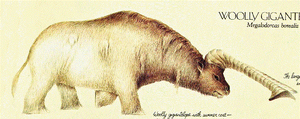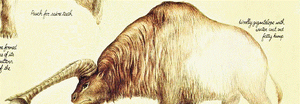
Woolly gigantelope with summer coat. Scruffy patches of winter coat remain throughout most of the summer.
The woolly gigantelope, Megalodorcas borealis, is a northern, tundra-dwelling, migratory gigantelope from the tundra of the Northern Continent, similar to a woolly mammoth.
For many large animals the tundra is only habitable during the summer months and in winter they migrate southwards into the coniferous forests, where conditions are less austere. The largest of these animals is the woolly gigantelope. It differs from equatorial gigantelopes mainly in size and in the possession of a large, fatty hump, which provides it with nourishment during the hungry winter months. It has a long, shaggy winter coat and broad hooves, which prevent it from sinking into soft snow. It uses its enormous horns as snow ploughs to expose the mosses, lichens and herbaceous plants on which it feeds. Its eyes are small to avoid being frostbitten and its nostrils are bordered by blood vessels that warm the air before it reaches the lungs.

Woolly gigantelope with winter coat and fatty hump. The large forward-pointing horns are used to clear snow from the vegetation in winter.
In early summer, the woolly gigantelope loses its shaggy coat and takes on a much sleeker appearance. The hump which sustained it through the winter months is now entirely depleted and it spends much of the time eating to rebuild its energy store for the long trek back south in the autumn.
Because of the woolly gigantelope's size (three meters at the shoulder without the hump and 7.5 tonnes in weight) there are very few predators powerful enough to threaten it. Its only real enemy is the bardelot.
